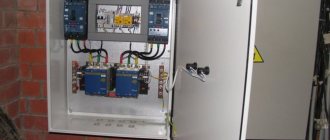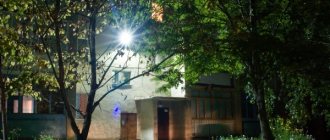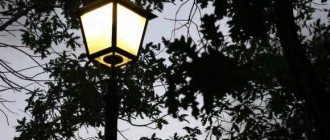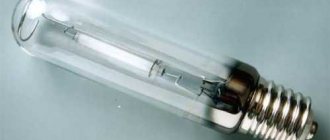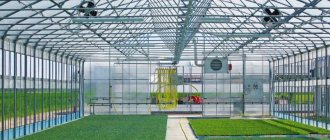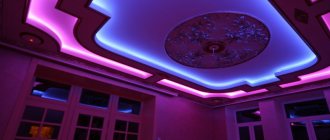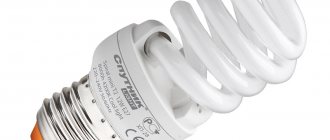What kind of lamps should be used for a greenhouse?
If you are growing crops whose value is in their stems and leaves, they do not need as much light as plants grown for their flowers and fruits.
This is what is taken into account when selecting lamps for a greenhouse. There are several criteria for choosing lamps:
- Manufacturer of artificial lighting. Everything is as clear as possible here - a branded product provides a certain guarantee of quality and good service. If you buy a cheap product on the market, then you can only guess about the quality, and service is not implied at all.
- Lamp power. This means how much energy the device will consume per hour of operation (continuous).
- Emitted energy. And this indicator will help you calculate how many lamps you will need to illuminate the greenhouse area well.
The light spectrum of the lamps is also important. But there are no such lamps, the artificial lighting of which will fully transmit the ultraviolet spectrum. Therefore, sometimes lamps are combined, and this is a good option. Well, the best option would be to purchase lamps with the greatest emission spectrum.
How to choose lamps for greenhouses: 5 tipsHow to produce LED lighting for greenhousesVentilation in a bathhouse diagram and device: 6 expert tipsOriginal tomato Makhitos F1: description and reviews
Each part of the light spectrum affects the plant in its own way:
- Violet and blue rays will accelerate photosynthesis in plant tissues - it becomes stronger and grows faster;
- Yellow and green rays, on the contrary, inhibit the process of photosynthesis, the stems become elongated and thinner;
- Orange and red rays are the best for plants, or rather, for their flowering and fruiting, but an excess of these rays threatens the life of the plant;
- Finally, ultraviolet rays form vitamins in leaves and fruits, making them more cold-resistant.
The best quality of light with fluorescent lamps is achieved by combining warm and cold light lamps. The service life of such devices ranges from 1000 to 2000 hours.
Correct lighting
Automatic watering in a greenhouse: features and types
Each crop needs a certain type of lighting. The intensity and duration of lighting is also highly individual. For cucumbers, for example, it is necessary to create special greenhouse conditions. LEDs are suitable for this in winter. Therefore, when planning additional lighting for a room, it is necessary to take into account all the slightest nuances and needs of the plants.
It should be noted that even with the latest modern technologies, there are no lamps that can emit light that is absolutely identical to natural ultraviolet.
Lamps emitting blue and violet rays have a positive effect on accelerating growth and strengthening seedlings. Lamps emitting red and orange rays should be used to illuminate plants during the flowering process, this will have a positive effect on the seedlings and help increase productivity. Lamps with ultraviolet radiation contribute to the overall strengthening of the plant and increase its resistance to cold.
Undoubtedly, natural sunlight is more familiar and useful for various crops, and no amount of artificial lighting, even the highest quality, can replace it. But not always, especially in the cold season, plants have enough ultraviolet radiation
Therefore, it is very important to use a variety of lighting fixtures to provide additional illumination to plants.
To create the most comfortable conditions for seedlings, you should remember some rules:
- additional illumination of seedlings is used only to extend daylight hours indoors;
- The duration of the backlight varies from ten to sixteen hours a day;
- Illumination of plants for twenty-four hours is strictly prohibited - this leads to depletion and cessation of plant growth and development.
How to organize optimal lighting for greenhouses
How much light is needed in a greenhouse and what should it be?
The greenhouse is already ready: there is a foundation, frame, glazing (film or cellular polycarbonate), soil is filled, ridges are formed. The technical issues of heating and watering have been thought through. And it seems like nothing has been forgotten... stop! Where is the lighting and is lighting needed for greenhouses at all? There seems to be enough natural light during the day, but at night the plants need to rest - so why pay for electricity in vain? Let's figure out together whether this reasoning is correct.
Why does a plant need light?
An important chemical process takes place in plants: the construction of giant organic chains from simple small molecules that “fold” into the plant itself. Any process requires energy, plants take it from light rays. A photon of light falling on the surface of a leaf triggers biochemical reactions, as a result of which mass grows - roots, stems, leaves and fruits. The process of combining atoms from simple mineral molecules into much more complex organic ones, which occurs in plants under the influence of light rays, is called photosynthesis. No light - no photosynthesis, and no photosynthesis - the plant does not grow. The roots do not grow, the shoots do not throw out new leaves, the buds do not form, and one can only dream about fruits.
How much light is needed and what kind of light it should be
The amount of light required by each plant species is different. In addition, it changes during the life of the plant. All cultivated plants require light, some more, some less. All nightshades are very photophilous, and peppers and eggplants are more photophilous than tomatoes and drop all their buds when there is insufficient light. The most shade-tolerant of tomatoes is cherry. Cucumbers, salads, parsley, onions and cabbage can “tolerate” a little, but dill cannot. The general principle here is this: all plants grown for flowers and fruits are more light-loving than those grown for edible leaves.
Plants also have such a characteristic as photoperiodicity. Its essence is that for a plant to transition to flowering and fruit formation, a certain duration of daylight hours is needed. “Long day plants” need more than twelve hours of light per day to begin flowering, while “short day plants” need less than twelve hours. There are plants that are neutral to the amount of daylight.
Why do different plants need different amounts of light?
Pumpkin and nightshade plants are short-day or neutral plants. Cabbage and root vegetables bloom during long days, which, of course, in their case, is completely undesirable. There may be some confusion with ornamental crops, since there are many of them and there is not always information about which photoperiodic group the next flower novelty belongs to. Among the ornamental crops there are also very special ones, for example Callistephus sinensis (Chinese aster), which blooms when a series of long days alternates with a series of short ones. The general rule is that tropical plants belong to the short-day group, while northern plants belong to the long-day group.
But even short-day plants (which is the majority of greenhouse plants) stop growing if the daylight period is less than ten hours. Therefore, if the plants do not grow, do not bloom, and the seedlings are stretched out, it will be necessary to provide the possibility of artificial supplementary lighting in the greenhouse. The most difficult thing is to choose lamps for lighting greenhouses, because you will have to choose from a good dozen options, varying in cost, energy consumption and color spectrum.
Until recently, there was an opinion that only the blue part of the spectrum is needed for vegetative growth, and the red part for fruiting. Compliance with this rule results in tasteless, “empty” vegetables and herbs that taste like ordinary grass. The plant needs the entire spectrum, not monochrome radiation, and this will have to be taken into account when choosing lamps. It should be noted right away that lamps that are completely similar in spectrum to sunlight have not yet been invented, and you may have to combine different types of lamps.
Types of lamps for supplementary lighting
- Incandescent lamps
The other side of the coin is their low efficiency: only half of the energy spent is spent on light radiation, the rest goes to heating the body. Even worse, incandescent lamps have a light spectrum unfavorable for plants: too much infrared, red and orange rays, which leads to stretching of stems and deformation of leaves. Therefore, incandescent lamps are not used for growing seedlings and producing fruits. They are only suitable for forcing: onions, root parsley, sorrel and other greens. To do this, they are suspended above the plants at a height of approximately 50 cm.
- Luminescent
They can be mounted in the greenhouse both horizontally and vertically. The main disadvantage: low light output, brightness directly depends on voltage. If there is insufficient voltage, the lamp may not turn on at all.
- Energy saving fluorescent lamps
They are easy to use, as they are screwed into a regular cartridge, do not require additional equipment, like luminescent ones, and are quite affordable. For owners of small greenhouses, they are perhaps more suitable than other lamps.
- High pressure mercury lamps (HPL)
Even in a special model for greenhouses, too much ultraviolet radiation inhibits plant development. This property of mercury lamps can be used if the seedlings are overgrown or stretched. They have high light output and low power consumption, and are easy to install. Ultraviolet lamps for greenhouses get very hot. The big disadvantage is the presence of mercury; if such a lamp breaks in a greenhouse, the entire crop will have to be thrown away.
- High pressure sodium lamps (NLVD, DNA, DnaT)
If a sodium lamp is specifically designed for greenhouses, it can imitate sunlight well, but it still lacks light in the blue part of the spectrum, which is important for vegetative growth of plants. Mirror lights for greenhouses with sodium lamps have reflectors, rotate and are installed in any desired position. Disadvantages: not everything is easy to connect; they require the presence of elements such as an IZU and a ballast in the circuit, which may prevent you from making greenhouse lighting with your own hands.
- Metal halide lamps (MGL, DRI)
They are considered almost ideal for greenhouses in terms of the light spectrum, but they are very expensive and short-lived, and the service life is highly dependent on the frequency of switching on the lamp.
- LED bulbs
The attractive thing is that LEDs consume little electricity and can illuminate (your choice) with blue, red or a combination of light. A new product is being developed - white LEDs that can cover the entire solar spectrum. When this happens, plants can be grown entirely under artificial light. Greenhouse lighting with LED lamps is environmentally friendly and safe.
The lamps provide a lot of light at low voltage and are produced for all existing types of bases. You can buy ready-made LED lamps, consisting of a lamp in a housing made specifically for it and a driver. The service life of the lamp is 3000-5000 hours, after which it is completely replaced. The only drawback of LED lamps and luminaires is their high cost (500-1000 rubles and more). It is better to purchase not Chinese, but domestic phyto-lamps, since the spectrum in them is already selected for our latitudes.
Self-electrification of the greenhouse
It’s good if the greenhouse is already electrified, then all that remains is to fix the selected lamps or insert the lamps into the sockets. If not, then it is best to invite an electrician to install the cable to the greenhouse, since there is a high risk of electric shock. The cable can be strung on poles or hidden in a trench. It is quite possible to carry out the preparatory work - installing poles or preparing a trench yourself, after watching the lighting for greenhouses video.
The depth of the trench must be at least eighty centimeters. It should not intersect with the drainage system. The cable laid at the bottom of the trench is covered with tiles on top so as not to accidentally damage it when digging in case you later forget where exactly it runs underground.
If it is decided to pull the cable through the air, then it is tightly tied to a wire stretched between the posts. You need to make sure that it is not touched by the branches of growing trees.
The cable is brought to the switchboard, and from it the wiring is already done to sockets and switches. It is necessary to take into account that the operation of electrical equipment in a greenhouse takes place at high air humidity and consider how to make the lighting in the greenhouse as electrical and fireproof as possible.
Let's summarize. If additional lighting is necessary, lamps are installed in greenhouses, the choice of which depends mainly on your budget. Lamps for greenhouses are turned on in the morning and evening, artificially lengthening the daylight hours to at least ten hours. All electrical wiring in the greenhouse must be perfectly insulated to prevent short circuits and electrical injuries. published
PS And remember, just by changing your consumption, we are changing the world together! © econet
Greenhouse lamps
Features of painting and types of paint for polycarbonate
You should dwell in more detail on the lamps that are commercially available in large quantities. Here we can only give a description of existing devices; each one chooses it individually and is guided by what is most acceptable in each individual case.
Incandescent lamps
These lamps illuminate the greenhouse quite well, but also heat the air. They have quite high energy consumption and have a light spectrum of about 600 denominations. This is not very beneficial for plants, but it is not critical either.
- They emit a lot of orange, red and infrared radiation. When such lighting is used for a long time, the stems of grown plants become greatly elongated and the foliage becomes deformed. The shoots may overheat or get burned.
- Illumination of seedlings in a greenhouse using such lamps is not allowed. You should also not grow cucumbers and tomatoes;
- Greenhouse lighting using such lamps is perfect for onions, parsley and many other green crops. In this case, the lamp itself should be fixed at a distance of 50 cm from the plant. Additional illumination should be carried out from 6 to 18 hours (this is without the presence of natural light).
High pressure mercury lamp
Lamps of this type heat up quite quickly, but this is not their biggest drawback. They have a fairly large emission of ultraviolet rays in the near spectrum.
Appearance of a high pressure mercury lamp
Economical fluorescent lamps
In general, these lamps are quite favorable for greenhouses. They are distinguished by great durability, low cost, but do not have great heat transfer. Lamps for greenhouses also work on this principle, but they can illuminate a much smaller area.
Samples of fluorescent lamps
Installation of such lamps is carried out either in a horizontal position using rectangular fittings, or in a vertical version using special housings.
High pressure sodium lamps
This is a fairly economical lighting option. They have high light output already at a power of 400 W. When the greenhouse is illuminated, a monochromatic light field is created that has a yellow-orange light.
Perfectly imitates natural sunlight. But they are weak in the blue part of the spectrum, which is important for the vegetative growth of planted plants.
Metal halide lamps are powerful
They have a fairly wide radiation spectrum and a large power range. They are rightfully considered an ideal option for a greenhouse. Their glow is as close as possible to the sun.
Only they are not durable and cost a lot. There are often restrictions on the combustion position, and this is not very convenient for use.
LED lamps for lighting
Using this backlight, you can illuminate plants with only one type of light, red or blue, and it is possible to combine light. They have a high cost, but low energy consumption. But it is white LEDs that scientists are pinning their hopes on at this time. Serious work and research are now being carried out on them.
The first to begin testing LED lamps in greenhouses was Denmark. Using 50,000 LEDs, savings amounted to about 40 percent. At the same time, plant growth occurred more intensively. With the use of such lamps in industrial greenhouses, there is less use of chemicals that regulate plant growth.
Installation of LED lamps is carried out in the traditional way, in linear systems, which are mounted using a flexible cable. This way you can adjust the orientation and height of the luminaires at the right time.
Recommendations
- Plants absorb only part of the range of light emission, waves that have a length of 400-700 nm. But still, it should be taken into account that ultraviolet and infrared radiation also affects the growth of plants in a greenhouse.
- There are two types of lighting: photoperiodic and constant type lighting. Application depends on the crops grown.
- High pressure sodium lamps are not ideal for use in a greenhouse. You should choose different light sources, it all depends on the type of crop being grown.
- You should not skimp on the quality of lighting equipment; good equipment will provide the best conditions and uniform illumination of plants.
- When installing lighting, you must comply with safety regulations and fire regulations.
Lighting for a greenhouse is almost the same as for a greenhouse. Do not neglect the quality of lighting fixtures and the harvest will please you.
How to calculate the required lighting brightness
In order not to make mistakes when calculating, you should remember:
- Choose lamps with light whose spectrum is as close as possible to natural sunlight. When supplementary illumination, select equipment with peaks in the red and blue spectrum.
- Consider lighting standards for a specific crop. Data can be found in special reference books or on plant growing websites (they are indicated in lux).
- Calculate the time depending on the length of daylight hours and cloud cover.
- Take into account the height of the lamps; the higher it is, the more powerful the equipment is needed.
Finally, another video.
Equipping lighting in a greenhouse is not difficult if you select the appropriate type of lamps and calculate the correct power. The main thing is to take into account energy consumption, since light costs depend on this.
How different plants are lit
Equipment for industrial greenhouses: operating principle, description
Some gardeners consider cucumbers to be an unpretentious crop, but this is not entirely true. If there are signs of a lack of light, care should be taken to install additional lamps. Cucumbers do not like a long break between lighting day and night. This can cause their growth to slow down and small, flaccid fruits to appear. To automatically illuminate cucumbers at any time of the day, you can use light relays.
Cucumbers should be continuously illuminated for 10-12 hours, after which they need a break of about 6 hours. At this time they need complete darkness. To stimulate the growth of cucumbers, blue spectrum lamps are needed, and during the flowering period, light sources with a red radiation spectrum will be needed.
Onions can grow well in natural light, but sometimes they need additional lighting. Phytolamps are most often used. The onion leaves become elastic, and the fruits become large and hard.
For strawberries grown in a greenhouse, fluorescent lamps 1 m long are suitable. Their power should be from 40 to 50 W. With one device you can provide light to 3-6 m2 of greenhouse space. For strawberries, 130 to 150 lux is enough, which it will regularly receive for 12-14 hours. In this case, only the warm spectrum is used.
Strawberries need constant daylight (from 14 to 18 hours a day). Under natural conditions, it begins to bloom in May. When grown in a greenhouse, daylight hours are increased by using neon, fluorescent or mercury light sources. This stimulates photosynthesis processes: the strawberry foliage will become a deep green color. When using artificial lighting, strawberries ripen much earlier than in the natural environment.
In the first days of growth, tomato seedlings are illuminated for 20 hours, gradually reducing the lighting intensity to 16-12 hours a day.
Choosing the right lighting for growing cucumbers, tomatoes and lettuce in a greenhouse
Required amount of light for different crops
For the good growth of any plant, both in natural and artificial environments, light is necessary.
For greenhouse plants, along with the amount of light, its quality is also important: light spectrum and photoperiodism (alternating lighting and shading)
This condition must be observed in order not to resort to artificial lighting in the summer, and to make the most of sunlight in the winter.
Tomatoes, cucumbers and greens are light-loving plants, so during cold weather, when the length of daylight hours is reduced, they need additional lighting. For each of these crops, according to experienced breeders, it is necessary to provide individual lighting conditions:
- for onions, herbs and lettuce, additional lighting is necessary only in the initial stages of development;
- for tomatoes, lighting should be provided continuously for 12 hours;
- for cucumbers there should be no break between natural light and artificial light - like tomatoes, they require at least 12 hours of light.
Proper lighting for cucumbers and tomatoes
Additional lighting for cucumbers and tomatoes in a greenhouse is required already at the stage of the first shoots in order to speed up the growth of seedlings and increase productivity. At the same time, for the correct flow of biological processes, they need to be provided with at least 6 hours of complete darkness. If you do not follow this rule, the plant may begin to lag in growth and drop flowers.
At the stage of vegetative growth, plants are recommended to be illuminated with a blue spectrum of light, and during the period of fruit set – with red light. Also, depending on the stage of development, the amount of light should be different: in the early stages it is better to organize lighting for 20 hours, gradually increasing it to 12 hours. Also, when organizing artificial lighting, it is necessary to take into account the light power: for plants, the radiation range should be from 400 to 700 nanometers.
Types of lighting for greenhouses and their properties
The following types of lamps can be used for artificial lighting of greenhouses:
- incandescent;
- mercury;
- sodium;
- LED;
- luminescent.
Let's look at each type of lighting in more detail.
It is better not to use ordinary incandescent lamps in greenhouses, since their light is unfavorable for plant growth. In addition, they are not economical to use and have a low radial radiation spectrum. They are not suitable for growing cucumbers and tomatoes: their strong heating can leave burns on the leaves.
Mercury vapor lamps produce very bright light and have a long service life. They are also not suitable for growing cucumbers, because, like incandescent lamps, they heat up very quickly and strongly during operation.
Sodium lamps are used mainly in industrial greenhouses: their light is close to natural, they have a high degree of yellow-orange spectrum output, and also provide additional heating. It is better to place them away from plants to avoid burns. They are also not recommended for growing cucumbers and tomatoes, since they only emit red light, which is only useful during the flowering period.
LED lamps are environmentally friendly lighting for modern greenhouses. Their main advantages are the following characteristics:
- maximum proximity to sunlight;
- durability of operation (up to 15 years without replacement);
- resistance to temperature changes and high humidity;
- resistant to mechanical damage.
Also, one of the best lamps for lighting greenhouses are fluorescent lamps: their light is very soft, gentle, they do not heat up during operation, create a favorable microclimate, are economical to operate and have a low cost.
For a group of plants, it is recommended to install 50-watt lamps at a height of 40-60 cm from the top. If the greenhouse area is large, then it is better to use 250-watt lamps and place them at a height of 1 to 2 meters.
When choosing artificial lighting, several parameters must be taken into account:
- crops for cultivation;
- greenhouse area;
- material for its manufacture;
- type of lighting and its properties.
If additional lighting is organized correctly, then a high yield of tomatoes and cucumbers can be obtained even in winter.
Features of using lamps in greenhouses and greenhouses
You can combine different types of light.
Before choosing equipment, you need to understand how lighting in a greenhouse differs from other options. It is important that the finished system meets several requirements:
- It is best to route the power cable underground. To do this, a wire with suitable characteristics is selected, which is laid in a trench at least a meter deep. To protect against damage and extend service life, the cable is placed in a polyethylene pipe.
- It is also worth making a diagram with all the light sources and switches. The wire must be laid in such a way as to prevent damage and protect the space. Select a cable with suitable characteristics, which is intended for use in conditions of high humidity and temperature changes. Ideally, lay the wiring in a corrugated or HDPE pipe.
- When attaching lamps, you need to remember that they should not interfere with natural light. Therefore, massive structures are not suitable.
- Since the light will work for a long time, when choosing, pay attention to energy consumption.
By the way! If lamps are not needed in summer, it is better to make the system quick-removable and put away for the warm period.
The video talks about mistakes when installing a greenhouse, installing heating and lighting.
Design Features
LED Technology
Before discussing how effective LED lighting is in a greenhouse, it is worth understanding the design of the devices used.
So, what is a modern LED lamp?
- As a rule, models used in agricultural technology are equipped with several dozen LED lamps. The more such lamps are included in the design of the device, the higher its power, and the more efficiently it illuminates the plants located under it.
- The design of the lamp can also be different: some devices use exclusively single-LED elements, while other models are equipped with lamps that operate on several LEDs.
- In any case, all parts of the lamp are assembled into a single circuit, which is connected to the power supply. The use of control circuits allows you to control the operation of the device, turning sections of the circuit on and off, as well as adjusting the brightness of the lighting.
Block model in a metal case with a built-in radiator.
Also an important part of such greenhouse lamps is the radiator. The main reason for using this element is the need to remove heat from the diode itself
In this case, the front part practically does not heat up, and all the heat is transferred to the radiator plates.
Greenhouse installation
Recently, lighting greenhouses with LEDs has become quite popular. In addition to greenhouses, this technology is also used in greenhouses, winter gardens, herbal aquariums - i.e. almost everywhere where it is necessary to ensure maximum efficiency of plant growth.
Installing lamps on a rack
As a rule, factory-made LEDs for greenhouses are produced in fairly durable housings that prevent moisture from entering the contacts.
In addition, they are equipped with special devices that greatly facilitate installation:
The most common technology is suspended installation of LED lamps. The device is fixed to the ceiling or supporting structure using cables or chains, and lowered to the required height. The low temperature of the working area allows the lamp to be placed fairly close to the plants, which increases the intensity of light absorption. Less commonly, lamps are installed on the ceiling itself
At the same time, it is worth choosing models with reflectors: although LEDs emit a narrowly directed light flux, it is still worth minimizing its losses. By the way, you should take into account that the lighting angle of lamps of this type is small. It is for this reason that you need to plan their placement very carefully, otherwise some of the beds risk remaining in the shade and not receiving enough light waves.
Portable model for vertical installation In addition to modular models, which are mounted in plastic or metal cases, sometimes LED strips for greenhouses are also used:
As a rule, tapes with fairly powerful diodes are used to illuminate plants. It is very important that the tape is protected from moisture, otherwise it will fail after just a few waterings. The optimal moisture protection classes are IP65 – IP67. For additional convenience and precise direction of the light flux, the tapes are mounted in special aluminum casings. Tape used in plant growing But by and large, tapes are only good for decorative lighting
So, if you want to ensure a decent harvest, choose high-quality modular devices
Tape used in plant growing But by and large, tapes are only good for decorative lighting. So, if you want to ensure a decent harvest, choose high-quality modular devices.
DIY greenhouse lighting with LED lamps
If you plan to install LED lamps in a large industrial greenhouse, it is better not to install the system yourself, since in this case there is a high risk of incorrect assembly and failure of the entire system after the start of operation. To reduce risks, it is better to immediately order ready-made systems from trusted manufacturers, and installation from professional electricians.
Figure 4. Preparation of lighting elements: 1 - purchasing LEDs and drivers, 2 - checking the polarity of the LEDs, 3 - preparing the aluminum profile, 4 - degreasing the LEDs
But, if the lighting is located in a small home greenhouse, you can make it yourself.
The correct assembly of an LED lighting system for a greenhouse is carried out as follows:
- Purchasing LEDs and LED Driver: In total you will need 10 lamps and 1 driver. It is better to choose lamps with a power of 3 W and a spectrum of 400-840 Nm. The lamps should have o. It is better to immediately buy lamps with a reserve so that, if necessary, a failed lamp can be quickly replaced. It is advisable to buy the driver in a special sealed plastic case. In this case, the power of the device should be 30 W.
- Checking LEDs: as a rule, the manufacturer indicates the polarity on the terminals of the LED arrays, but to avoid troubles during installation, it is better to check this indicator with a multimeter in diode test mode. The probes of the device are connected to the contact tracks according to the indicated polarity, and the diode itself should light up.
- Profile processing: To install the lighting system, you will also need an aluminum profile 1 meter long. Its ends should be covered with sandpaper to remove burrs, and the side that will be used for installation should be disinfected with alcohol.
- Processing LED matrices: the metal surface of the matrices also needs to be degreased with alcohol. To do this, the elements can simply be placed on a cotton pad soaked in alcohol. It is not recommended to remove them from the disk before installation, as this may lead to re-contamination (Figure 4).
- Profile marking: marks are made on a processed piece of aluminum profile for future mounting locations for LEDs and holes are drilled. A distance of 9 cm is considered optimal. Special hot-melt adhesive is applied to the degreased surface of the profile and LED matrices are glued. At the same time, it is advisable to place their positive terminals in one direction, so that in the future it will be easier for you to solder the wires.
- Preparation of the installation wire: the MGTF installation wire is cut into pieces 12-13 cm long, the ends are stripped and tinned with a soldering iron. Next, the wires need to be soldered to the LEDs. In this case, polarity must be observed: the plus of the first LED is soldered to the minus of the second, and so on.
- Connection: on the back side of the profile, make two holes in the center, with a diameter of no more than 4 mm. At a distance of 10-15 cm from them, another hole is made, with a diameter of 1 cm. Two pieces 75 cm long are cut from the wire, inserted into the holes and brought out to different ends of the profile. The ends of these wires are soldered to the LEDs according to polarity. A double wire with a plug is inserted from one end of the profile, which is taken out through a large hole. The ends of this wire are connected to the driver (Figure 5).
Figure 5. Installation of the LED lamp: 1 - attaching the LEDs to hot glue, 2 - connecting the LEDs by soldering, 3 - connecting the LEDs to the driver, 4 - attaching the lamp.
At the final stage, you need to attach brackets to the back side of the profile, with which the structure will be fixed inside the greenhouse over the plants.
The assembly of an LED lamp for greenhouse plants is shown step by step in detail in the video.
Lighting time
The lighting time depends on how light-loving the crop is. For tomatoes, cucumbers, salads and bell peppers, the length of daylight should be 10 hours or more.
There are short day plants. It is the short daylight hours that cause them to begin to bloom. When daylight hours become longer, their growing season comes to an end and they begin to develop as usual. In long-day plants, flowering occurs when the daylight hours are more than 13 hours. If it is shorter, their fruits will become small or stop appearing altogether.
There are cultures for which the length of daylight hours does not matter. They grow independently of it, the main thing is that there is not too little light. If there is not enough of it, the plants will die.
Photo of greenhouse lighting
DIY chandelier - manufacturing instructions and master class on creating design modelsIncandescent lamp: design, application and connection features (85 photos)
Dimmable LED lamps: detailed description of the device, selection and tips for using dimmable LED lamps
Read here! Home lighting: general principles and rules for implementing electrical wiring (105 photos)
Kinds
When choosing an IR heater, one takes into account several criteria.
Existing types of “infrared” can be:
- electrical;
- gas (halogen);
- diesel.
Heating element type
Electric heaters are equipped with the following types of heating elements.
- Ceramic - they have increased strength, heating for them is a matter of minutes, they cool down just as quickly;
- Heating elements - the advantages of tubular electric heaters are reliability and stable maintenance of the set temperature;
- Carbon - the design of such a heater is represented by vacuum tubes with carbon-hydrogen fibrous filler.
Form
In appearance, heaters can be infrared lamps of various formats, film panels or tapes. Compared to lamps, film or tapes provide the greatest energy savings and heat the soil more evenly.
Installation method
Before purchasing a “personal sun”, you should immediately decide on the placement of the device.
Depending on the mounting method, the equipment can be:
- mobile;
- stationary.
There are no questions regarding the first one - this is a portable equipment that can be moved to the desired location using wheels or special legs.
You can experiment with the installation of stationary models as much as you like, since they are available in several types:
- ceiling;
- wall;
- baseboard;
- hanging.
Suspended models differ from ceiling ones in the principle of fastening. Suspension-type heaters are built into a suspended ceiling structure, which is pre-designed for the placement of devices. To fix hanging devices, use special brackets and anchor bolts in increments of 5 to 7 cm.
Heating temperature
IR equipment differs in the degree of heating of the device itself.
Devices can be:
- low temperature – up to 600°C;
- medium temperature – from 600 to 1000°C;
- high temperature – more than 1000°C.
Emission range
In accordance with this parameter, IR equipment is:
- long wave;
- medium wave;
- shortwave.
According to Wien's law, there is a direct relationship between the wavelength and the temperature of the surface on which the radiation hits. Under high-temperature radiation, the wavelength increases, but at the same time they become hard and become dangerous.
IR heaters have additional options.
- Many models of infrared equipment have a thermostat (temperature regulator) that is responsible for maintaining the set temperature.
- Any thermal heater must be equipped with a thermal switch that reacts to overloads and automatically turns off the device, preventing it from overheating.
- To ensure comprehensive safety, IR equipment is also equipped with insulators that prevent contact of the housing with the heating element.
- Particularly advanced models have a light indication that informs the user about a problem that has arisen so that he can quickly navigate and take measures to eliminate it.
- Spontaneous shutdown of floor-standing models occurs when tipped over, which simultaneously prevents damage and reduces the risk of fire to zero.
- The presence of the Antifrost system is designed to protect the heating device from the formation of ice. Even if the heater is used in harsh Russian winters, you don’t have to worry about the performance of the IR equipment.
- Many models of infrared heaters have a timer, which makes operation much more comfortable. Thanks to the ability to set the desired on and off times, you can reduce fuel costs.
Electric lighting in the service of greenhouses
From the middle of the last century to the present day, electric lamps have been the optimal source of artificial lighting for greenhouses. But in order to get high-quality additional lighting and increase plant productivity, you need to approach the choice of lamps as responsibly as possible.
The modern lighting market offers a large selection of lighting devices for greenhouses, which differ in light sources, level of energy consumption, lighting efficiency, price and many other parameters. When buying lamps, you need to rely on the following characteristics:
- Power (Watt) - energy consumption of the device per hour of continuous operation.
- Luminous flux (lumen) - having information about the amount of light emitted by each lamp, it will be possible to organize a lighting system with the optimal number of lamps.
- The color spectrum of light is electromagnetic waves of different lengths perceived by plant pigments. For example, substances that capture light waves in the red segment of the spectrum are responsible for the full development of roots and fruits. The pigments of the green biomass of the plant react to rays of the blue spectral range. To stimulate photosynthesis in the leaves of the lower tier, yellow-green light waves are needed. Another important factor that needs to be taken into account when organizing artificial lighting in a greenhouse is ultraviolet light. The invisible, but important part of light radiation prevents excessive elongation of the stem, making plants resistant to cold and microorganisms. The optimal greenhouse lighting system should consist of devices with radiation of a wide spectral range - in this case, the lamps will stimulate both the vegetative development of plants and the ripening of fruits.
- Economical - the greenhouse lighting system must have an optimal ratio of power and electricity consumption. Energy-intensive lighting equipment leads to significant energy costs, reduces the profitability of the agricultural enterprise and negates all the benefits of high yields.
- Level of protection against dust and moisture (IP) - lamps protected from the negative effects of external factors are the best option for greenhouse structures where the soil is a source of dust, and regular watering leads to a high level of humidity. The most suitable here are devices with IP67, which have an impenetrable housing and additional sealing of lighting and power elements.
LED strip for greenhouse
An LED strip is a narrow, up to 5 meters long strip of flexible material - essentially a plastic modification of a printed circuit board with ice elements located at an equal distance and with a given density. Among other advantages, its ease of use lies in its ease of installation - on the reverse side there is a self-adhesive base with which the product can be fixed to elements of a metal frame or a special profile.
The scope of its application is quite wide - it can be mounted both for the main and for additional lighting of greenhouses, hotbeds, covered beds, as well as simply on a windowsill with seedlings. It is especially important to use such an LED lamp when the height is small and the structure is sufficiently long for growing plants.
When choosing an LED strip, it is important to consider several important parameters:
- Type of diodes. They are mainly characterized by crystal sizes 3528, 2835, 5050, etc. The main difference between them is the intensity of the light flux. Thus, the LED element 5050 produces 12 Lm, and 3528 – 5 Lm. Knowing the required power for a specific crop, you can calculate how many lamps should be on 1 meter of ice strip.
- LED strips, specially produced for greenhouses, have a specified frequency of ice crystals that glow only in blue and red. This characteristic is indicated in the product labeling. For example, 15:5 means that 15 red diodes replace 5 blue diodes and this alternation continues along the entire length of the strip. The combination of two main segments of the light flux spectrum allows you to optimize and accelerate plant growth.
- Degree of moisture resistance. For greenhouses, conservatories and greenhouses, the protection index should start from IP65 and above.
LED strip, unlike lamps, does not generate much thermal energy. This allows you to place it as close as possible to plant parts (up to 15 cm), without the risk of scorching them. This increases light absorption and makes it possible to reduce lighting power and, therefore, save on costs for lighting the greenhouse.
Features of LED lamps
Under natural conditions, the plant is illuminated by sunlight, which is a set of radiation of seven different colors. In contrast, lamps used for artificial lighting operate in a fairly narrow spectral range. For example, traditional incandescent light bulbs are characterized by a temperature of about 2800K, while the Sun produces a luminous flux of 5000K.
This cannot be ignored when choosing lamps for greenhouses, including LED types. The closer the lighting characteristics of the lighting are to natural ones, the more benefits the crops will receive. In addition, at different stages of development, plants require radiation from a specific part of the spectrum. For example, during the growing season it is a blue tint, and during flowering and mass gain it is red.
Currently, there are LED lamps and other lamps of this type to provide the best lighting in a greenhouse. With their help, you can create economical, bright and rich colored lighting. The RGB version of ice stripes is especially convenient. With their help, you can switch the shade of radiation in accordance with a given program. In addition, LED elements have an optimal ratio between blue and red.
Day and night lighting in the greenhouse
During natural lighting greenhouse lamps with a density of 400-1000 mmol/m² are used. To prolong the night glow, photoperiodic artificial lighting of greenhouses is practiced with an energy dose of 5-10 mmol/m2.
When calculating greenhouse lighting, plants with different light needs are identified. This factor is also considered in greenhouse lighting. Designs with an effective built-in method of controlling the processes of flowering and flora growth are common - cyclic light supply . The essence of the operation of such a system is short-term illumination for a regulated period of time.
Uniform light has a huge impact on the development of crops. Numerous lamps in greenhouses are responsible for this function. Special reflectors with the function of reflecting light here With their help, the same light supply is provided to the plant crops that grow under them.
Lamp selection
In the cold season, the duration of daylight hours is insufficient for the full development of plants, so additional lighting in the greenhouse is necessary in winter. Today the market is not able to offer a universal solution. To create comfortable conditions in the greenhouse, you should select several types of lamps. A balanced system will allow you to grow a bountiful harvest all year round.
Specialized stores offer a wide variety of lamps for greenhouses; how can you choose the right one and not get lost in this variety if marketers praise the products in every possible way? To do this, you should study the main characteristics of the lamps.
How to make lighting in a greenhouse, diagram for Dnat lamps
Incandescent lamp
Incandescent lamps provide excellent illumination of the greenhouse and serve as a slight heating for the air. But they are not economically profitable: too much energy consumption. The spectrum of incandescent lamps is 600 nm, which is not at all conducive to the normal development of plants. If such lighting is abused, plants get burned, as an excess of orange, infrared, and red rays are formed. The stems stretch unnaturally, and the leaves become deformed.
Fluorescent lamps
Fluorescent lamps have a favorable spectrum for growing plants. They are durable, relatively inexpensive, and the heat transfer of such lamps is very low. The principle of operation is identical to light-saving ones, but the latter are capable of illuminating only a small area.
Fluorescent lamps are installed in special metal boxes, less often vertically in plastic lighting fixtures.
Ultraviolet lamps for greenhouses
Modern ultraviolet lamps operate on the principle of fluorescent lamps: UV radiation is generated in the bulb due to the interaction of an electromagnetic discharge and mercury. A gas discharge tube is made from uviol or quartz glass, which has the properties of transmitting UV rays. Uviols are safer because they reduce the level of ozone formation. By adding different components during glass production, manufacturers create lamps that operate in a strictly specified range, so that a favorable lighting spectrum can be selected.
Lighting in a polycarbonate greenhouse with ultraviolet lamps
Mercury vapor lamps
DRL high pressure mercury lamps. They heat up quickly and emit rays from the near ultraviolet spectrum. Such lighting is useful for improving photosynthesis in very small quantities, combined with sunlight. Recommended for use during fruit ripening. Not safe, operation is possible at a stable voltage, differences cannot be more than 5%.
Using mercury lamps in a greenhouse
Sodium lamps
High pressure sodium lamps (denas, dnas, dnat). Very economical, with high heat output, it is effective to use lamps with a power of more than 400 W for greenhouse lighting. Sodium lamps for greenhouses create orange-red monochrome lighting similar to that of the sun. The downside of the lamps is that there are few blue rays. Manufacturers have improved the product; now you can buy an improved version of lamps for greenhouses with more intense rays of the blue spectrum. Experts have noticed the ability of sodium lamps to attract insect pests, which is a significant obstacle to their use in a greenhouse.
The photo shows a sodium lamp
LED bulbs
LED lamps for greenhouses (LED) individually create monochrome lighting, but a huge range of products allows you to choose a combination of LEDs and create a favorable spectrum individually for each type of plant. LEDs for greenhouses are economical, durable, and work properly at low voltage. The light intensity can be adjusted by the number of lamps and by placing the lamps at different heights. When seedlings grow, it is better to illuminate the greenhouse with blue-spectrum LED lamps; for fruit ripening, orange and red segments of rays should be used.
Professional LED lamps for greenhouses – illumination in several spectra
Selecting a light source
In addition to choosing the lamp itself, it is necessary to select a light source for it. Today, the following light sources can be used to illuminate greenhouses in winter:
- incandescent lamps. The most outdated type of light source, which is used only out of habit. Even though they are still on sale, their era has come to its logical end. This is due to the fact that incandescent lamps have low efficiency and low energy efficiency;
Illumination of greenhouses with incandescent lamps
- mercury lamps. They proved to be more efficient than the incandescent lamps that were their prototypes. Mercury lamps emit a spectrum suitable for plants and are affordable. But their disadvantages include the presence of mercury vapor inside the glass flask, which, when damaged, enters the air. And this poses a threat to people’s lives and the usefulness of fruits grown in a greenhouse. Also, such light sources emit a certain proportion of ultraviolet radiation;
Illumination of greenhouses with mercury lamps
- sodium lamps. They are safer than mercury lamps, as they break much less often. Such bulbs are chosen for illuminating flowering crops, since red rays predominate in their emission spectrum. As a result, the light from sodium lamps stimulates the formation of ovaries and large fruits. The disadvantages of lamps include their high cost;
Illumination of greenhouses with sodium lamps
- halogen lamps. They are not used very often in greenhouses, since their installation is quite complicated and expensive. At the same time, the service life of the light bulb is low and they are afraid of moisture (they can explode if exposed to water). The advantages of halogen lamps include high light output, as well as the ability to save on heating the greenhouse in winter. Such lamps should be placed above the plantings at a distance of 30-90 cm from the bushes;
Illumination of greenhouses with halogen lamps
- fluorescent lamps. They are used very often for lighting greenhouses. Such light bulbs are not expensive, do not get particularly hot and have a long service life. But a significant disadvantage of such products is their low light output. Also, their installation will require additional structures, which are quite problematic to assemble with your own hands;
Illumination of greenhouses with fluorescent lamps
The best solution in this situation would be to use an LED lamp. Such light bulbs are the most profitable in terms of energy consumption. At the same time, LED lamps have all the characteristics necessary for the growth and development of plants.
Illumination of greenhouses with LED lamps
But buying LED products will not be cheap. But you will definitely get a high-quality and tasty harvest from the winter greenhouse. And finally, it is worth noting that automation of the lighting system will help achieve additional light savings when lighting greenhouses in winter.

